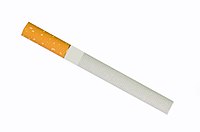
Photo from wikipedia
Background Food flavors are relatively low molecular weight chemicals with unique odor-related functional groups that may also be associated with mutagenicity. These chemicals are often difficult to test for mutagenicity… Click to show full abstract
Background Food flavors are relatively low molecular weight chemicals with unique odor-related functional groups that may also be associated with mutagenicity. These chemicals are often difficult to test for mutagenicity by the Ames test because of their low production and peculiar odor. Therefore, application of the quantitative structure–activity relationship (QSAR) approach is being considered. We used the StarDrop™ Auto-Modeller™ to develop a new QSAR model. Results In the first step, we developed a new robust Ames database of 406 food flavor chemicals consisting of existing Ames flavor chemical data and newly acquired Ames test data. Ames results for some existing flavor chemicals have been revised by expert reviews. We also collected 428 Ames test datasets for industrial chemicals from other databases that are structurally similar to flavor chemicals. A total of 834 chemicals’ Ames test datasets were used to develop the new QSAR models. We repeated the development and verification of prototypes by selecting appropriate modeling methods and descriptors and developed a local QSAR model. A new QSAR model “StarDrop NIHS 834_67” showed excellent performance (sensitivity: 79.5%, specificity: 96.4%, accuracy: 94.6%) for predicting Ames mutagenicity of 406 food flavors and was better than other commercial QSAR tools. Conclusions A local QSAR model, StarDrop NIHS 834_67, was customized to predict the Ames mutagenicity of food flavor chemicals and other low molecular weight chemicals. The model can be used to assess the mutagenicity of food flavors without actual testing.
Journal Title: Genes and Environment
Year Published: 2021
Link to full text (if available)
Share on Social Media: Sign Up to like & get
recommendations!